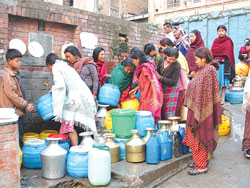 Low rainfall in winter is not unusual in a country with geography like Nepal's. But what seems extraordinary, and cause for serious concern, is the absence of rain for more than four months now. The 2005 drought was the country's worst for nearly 100 years. The last time Kathmandu saw rain was on 22 October and there is still no sign of spring showers. By this time of year, 54 mm of rain should have fallen on average. The drought has also affected India and Bangladesh.The lack of snow in our mountains, especially in the centre and east has affected power generation and irrigation downstream. This is a trend: precipitation has been diminishing every year for the past decade. The same change in weather pattern that has cut rainfall is probably the reason for the growing cold wave in the tarai, which was deeper and more widespread last winter than in many recent years. Most shocking was when the temperature in alpine Jumla was warmer than usually tropical Nepalganj. Drought manifests itself in three phases-dryness, food shortage and famine. At present, Nepal is entering the second phase. Nepal's agriculture is predominantly rainfed, and even where there is irrigation there is no water because streams and springs have dried up. There is a real danger of the water shortage turning into a crisis in coming days and a crucial need to look for alternative water sources. We all know that Nepal is a water-rich country but that will seem meaningless if no rain falls and as we see more and more the effect of climate change and variability.
Low rainfall in winter is not unusual in a country with geography like Nepal's. But what seems extraordinary, and cause for serious concern, is the absence of rain for more than four months now. The 2005 drought was the country's worst for nearly 100 years. The last time Kathmandu saw rain was on 22 October and there is still no sign of spring showers. By this time of year, 54 mm of rain should have fallen on average. The drought has also affected India and Bangladesh.The lack of snow in our mountains, especially in the centre and east has affected power generation and irrigation downstream. This is a trend: precipitation has been diminishing every year for the past decade. The same change in weather pattern that has cut rainfall is probably the reason for the growing cold wave in the tarai, which was deeper and more widespread last winter than in many recent years. Most shocking was when the temperature in alpine Jumla was warmer than usually tropical Nepalganj. Drought manifests itself in three phases-dryness, food shortage and famine. At present, Nepal is entering the second phase. Nepal's agriculture is predominantly rainfed, and even where there is irrigation there is no water because streams and springs have dried up. There is a real danger of the water shortage turning into a crisis in coming days and a crucial need to look for alternative water sources. We all know that Nepal is a water-rich country but that will seem meaningless if no rain falls and as we see more and more the effect of climate change and variability. 

